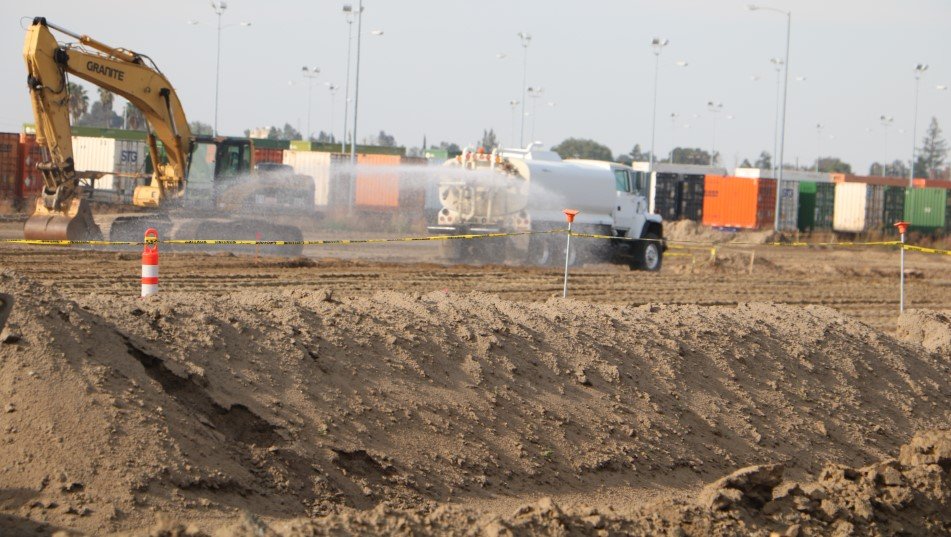It is without the doubt the most significant construction project so far this century in terms of having a daily impact on every Manteca resident.
The project is the expansion that is now underway at the Union Pacific intermodal yard squeezed in between Manteca and Lathrop west of Airport Way and bordered by Lathrop Road and Roth Road.
When everything is said and done, the capacity will be in place that will allow a 260 percent increase in “lifts” each year.
“Lifts” is railroad lingo for the number of shipping containers or truck trailers that can be lifted on or from rail cars.
That means the 280,000 or so annual truck trips to and from the intermodal facility can max out at 730,000 based on Union Pacific documents.
As such, it reflects a potential 260 percent increase of truck traffic that needs to make its way through Lathrop and Manteca to reach major freeways.
Most of that traffic will use Roth Road to reach Interstate 5.
But plans are in the works for a truck route that would allow trucks to reach the 120 Bypass via McKinley Avenue to tie into the interchange now under construction.
The truck route also would tie into Highway 99 via Airport Way to French Camp Road.
At any rate, the current daily average of 767 truck movements or 31 in an average hour will be able to top out at 2,000 a day or 83 on a prorated hourly basis.
That’s an average daily increase of 1,233 truck trips a day.
But it’s not just truck traffic that will increase.
Union Pacific anticipates a major jump in train movements.
In 2019, the railroad advised the City of Manteca in the coming decades it anticipates bumping up the number of trains that pass through the city to as much as 135.
That compared with 56 trains in 2019.
To put that in perspective, in 2019 there was a train basically passing through Manteca every 25 minutes.
The projected 135 trains a day translates into a train rumbling through the city roughly just over every 10 minutes on average.
Keep in mind that is divvied up between two railroad lines: The Fresno line that cuts through the center of Manteca and the Altamont line that serves as the boundary between Manteca and Lathrop.
The busiest of the two by far is the Fresno line that has 10 at-grade crossings. The Altamont line has four at-grade crossings.
When the new Austin Road interchange is completed, it will clear the railroad tracks, reducing the at-grade crossing to nine along the Fresno line.
The 135 train count doesn’t include ACE service that will be expanded south through downtown Manteca in 2026.
Then there is the high speed rail connector trains anticipated to start passing through Manteca in the early part of the next decade to reach San Jose and Sacramento when the Bakersfield to Merced line is completed. The transfer in Merced to ACE will occur until such time the high speed route under Pacheco Pass is constructed.
All of abovementioned doesn’t include the fact Manteca is impacted somewhat by a second intermodal facility.
Santa Fe Railroad’s intermodal facility along Mariposa Road less than 6 miles northeast of Manteca is sandwiched between Austin Road and Jack Tone Road.
Its capacity has been expanded from 120,000 to 300,000 lifts a year.
Between the Union Pacific and Santa Fe facilities, that translates into the potential for 3,561 truck movements on average daily on area freeways and truck routes.
The Union Pacific expects to reach capacity at the Lathrop intermodal yard in 20 to 35 years.
That also is the time range they expect to reach 135 train movements during a typical 24 hour period.
Why 135 daily trains, plus
730,000 annual truck trips have
a good chance of happening
Intermodal freight movement is expected to keep growing.
The reasons are:
*Based on greenhouse gas emissions it creates up to 75 percent less emissions for the long-haul movement of freight while using trucks on either end to move freight from its origin or destination.
*A single intermodal train can take between 140 and 200 long-haul trucks off highways.
*The cost is lower.
*There is a growing shortage of long-haul truck drivers.
*Intermodal using shipping containers dovetails well into the growing export-import business.
The Stockton, Lathrop-Manteca, and Tracy areas constitute the hub of a logistics center that serves 18 million Northern California consumers.
There are two limited capacity intermodal facilities near the Port of Oakland — one operated by Santa Fe and the other by Union Pacific.
The only other intermodal facilities in the north state are sandwiched between Lathrop and Manteca and less than 6 miles northeast of Manteca and east of Stockton.
Union Pacific has seven intermodal facilities in California and Santa Fe has five.
The impact of railroads in US
& Union Pacific in California
Railroads, between raw materials and finished products, move an average of 61 tons per American each year.
They do so over 140,000 route miles.
Railroads generate nearly $80 billion a year in revenue and provide 167,000 jobs.
Union Pacific in California:
*operates 3,362 miles of track.
*has an annual payroll of $347.2 million.
*has capital investments of $309.5 million.
*employs 3,096 workers.
*gives $1.3 million to community endeavors.
*originates 1.4 million rail cars.
*terminates 1.5 million rail cars.
Based on 2022 volumes, the five top commodities shipped on UP trains from California are intermodal-wholesale, auto parts, assembled autos, canned and paste foods, and cement/miscellaneous building materials.
The five topped commodities received are intermodal wholesale, assembled autos, auto parts, grain and biofuels/sweeteners.
To contact Dennis Wyatt, email dwyatt@mantecabulletin.com





